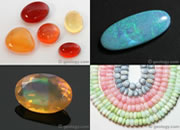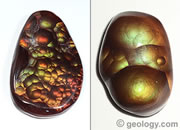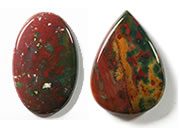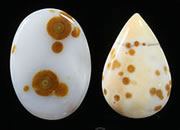Home » Gemstones » United States Gemstone Production and Consumption
Gemstone Production and Consumption in the USA
The Gemstone Market in the United States is Dominated by Imported Diamonds
Author: Hobart M. King, PhD, GIA Graduate Gemologist

Maine tourmaline: The first commercial gemstone mine in the United States that was operated by miners other than Native Americans was at Mount Mica, Maine. There a large deposit of tourmaline was discovered by two boys in 1820. Two years later a mine was opened which has yielded thousands of carats of gem-quality crystals. The three cut tourmalines above are from the Dunton Quarry, Newry, Oxford County, Maine (left 29.67 carats, middle 20.01 carats, right 27.43 carats). Photo by Thuss Photography. Used with permission of the Maine State Museum.
The World's Leading Consumer of Gemstones
People in the United States love gemstones and have disposable income to buy them. More gemstones are sold in the United States than in any other country on Earth. In 2013, U.S. consumers purchased 35% of the world's supply of gemstones - yet the United States only has about 4.4% of the global population. [1]
In 2016, U.S. consumers spent about $25.68 billion on gemstones. Over 99% of these gemstones were imported because the United States has very little domestic gemstone production. As the world's largest consumer of gemstones, the United States is dependent upon a supply of stones mined mainly in developing countries. [2]
| What is a Gemstone? The Minerals Yearbook, published by the U.S. Geological Survey, uses the word "gemstone" for any mineral or organic material - such as amber, pearl, petrified wood and shell - that is used for personal adornment, display or art object because of its beauty, durability and rarity. That definition will be used throughout this article. [1] |
A Market Dominated by Diamonds
Diamonds are the favorite gemstone of United States consumers. Almost 93% of the money spent on gemstones in the United States is used to buy diamonds. Diamonds account for about $23.5 billion of the United States gemstone market and colored stones account for only about $2.18 billion. [1]
An important reason for the diamond dominance is that diamond is the gemstone traditionally used in engagement rings. The typical engagement ring costs several thousand dollars, contains a white diamond, and millions of these rings are purchased each year.

Native American shell and turquoise jewelry found near the Tonto Cliff Dwellings at Tonto National Monument, Arizona. National Park Service image.
History of Gemstone Mining in the United States
Gemstones have been produced in what is now the United States for thousands of years. Native Americans produced turquoise, flint, amber, shells, obsidian and other materials for use in jewelry, beads, carvings, and tools. In the southwest they mined turquoise and used it to make earrings and pendants. Along the Atlantic and Gulf coasts, shells were used as gemstones, ornaments and currency. The use of flint for making tools and ornaments was widespread.
About 60 types of gemstones have been produced in the United States. The most important gemstones in current production include: agates, beryl, coral, diamond, garnet, jade, jasper, opal, pearls, quartz, sapphire, shell, topaz, tourmaline, turquoise and others. These stones are used for jewelry, carvings, and as specimens by gem and mineral collectors.
In 2016, twelve states produced about 90% of the natural gemstones mined in the United States. In descending order of production, these states were: Idaho, Arizona, Oregon, California, Montana, Arkansas, Maine, Colorado, North Carolina, Nevada, Texas, and Utah.
Diamond Mining in the United States
Only one diamond mine is active in the United States, the Crater of Diamonds Mine located near Murfreesboro, Arkansas. There amateur collectors can pay a fee to look for diamonds and keep any that they find. Collectors find a few hundred carats per year.
Diamonds found at the Crater of Diamonds mine are highly valued because many people want to patronize this gemstone locality - they want to own an "American Diamond" or an "Arkansas Diamond." The stones often sell for several times the price of equivalent-quality stones produced in Africa, Canada or other locations.
U.S. Gemstone Production | ||
| Gem Material | 2012 | 2013 |
| Beryl | 1790 | 191 |
| Coral | 150 | 138 |
| Garnet | 98 | 92 |
| Gem Feldspar | 757 | 698 |
| Geode / Nodules | 89 | 89 |
| Opal | 74 | 93 |
| Macrocrystalline Quartz | 383 | 384 |
| Cryptocrystalline Quartz | 261 | 199 |
| Sapphire / Ruby | 360 | 266 |
| Shell | 810 | 695 |
| Tourmaline | 99 | 94 |
| Turquoise | 1320 | 1310 |
| Other | 5140 | 5330 |
| Totals | 11300 | 9570 |
Colored Stone Mining in the United States
Colored stones are produced commercially from a few hundred mines in the United States. These mines are typically very small - with a few employees who often work part-time. Gemstone mining employment in the entire United States is estimated to be between 1200 and 1500 people.
A significant portion of the United States' production of colored stones is done by collectors, gem clubs and hobbyists instead of businesses. [1] Many of the mines are not operated by employees. Instead they are open for public collecting, where, for a fee, anyone can enter the mine, look for gemstones and keep whatever is found.
"Pay-to-Dig" Mining
Each year thousands of gemstone collectors, prospectors, rockhounds and other interested people visit hundreds of these pay-to-dig mines across the United States. Most states have several pay-to-dig mines where anyone can visit, pay a small fee and try their luck at finding some nice gems. Many of these mines are very popular and are visited by thousands of people per year.
Even though the pay-to-dig fee is very small, these operations produce a substantial amount of local commerce, once the price of hotel rooms, campgrounds, restaurants, gasoline and on-site purchases of everything from work gloves to goggles to Gatorade are considered. The business-generation value is many times the pay-to-dig fee.
Directories of pay-to-dig mining operations have been published for the western and eastern United States. For a photo visit to a very popular pay-to-dig mining operation, see our article on Herkimer Diamonds.
United States Statistics | 2012 | 2013 | 2014 | 2015 | 2016 |
| Natural Gemstone Production | 11.3 | 9.6 | 9.5 | 8.5 | 8.5 |
| Laboratory-Created Gemstone Production | 31.2 | 56.9 | 51.0 | 55.1 | 57.3 |
| Imports for Consumption | 21,500 | 24,700 | 26,400 | 25,100 | 25,600 |
| Exports and Reexports | 16,900 | 19,400 | 21,300 | 18,500 | 19,500 |
| Apparent Consumption | 4,640 | 5,400 | 5,160 | 6,660 | 6,170 |
Synthetic Gemstone Production
Of the $66.5 million worth of gemstones produced in the United States in 2013, only $9.57 million were natural stones and the remaining $56.9 million were laboratory-created. [1] Laboratory-created gemstones have the same chemical, optical, and physical properties of a natural stone but have been manufactured by humans. Law requires that these stones be clearly marked so that they are not confused by the consumer with natural stones. The laboratory-created stones produced in the United States include: alexandrite, cubic zirconia, diamond, emerald, garnet, moissanite, ruby, sapphire, spinel, and turquoise. [1]
| Information Sources |
|
[1] Olson, Donald W., (2013). 2013 Minerals Yearbook: Gemstones. 2013 Minerals Yearbook, Volume I, Metals and Minerals, Gemstones. United States Geological Survey.
[2] Olson, Donald W., (2017). 2017 Mineral Commodity Summary: Gemstones. United States Geological Survey. |
Simulant Gemstones
Another category of gemstones is simulant gemstones. Simulants look like natural gemstone material but have different chemical, optical, and physical properties. They are typically made from glass, plastic or other materials. The value of simulant gemstones produced in the United States exceeds $100 million per year.
| More Gemstones |
 |
Pictures of Opal |
 |
Diamond |
 |
Fire Agate |
 |
Birthstones |
 |
Gifts That Rock |
 |
Blue Gemstones |
 |
Bloodstone |
 |
Polka Dot Agate |

Find Other Topics on Geology.com:

|

| ||

|

| ||

|

| ||

|

|
